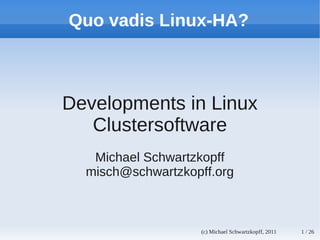Developments in linux
- 1. Quo vadis Linux-HA? Developments in Linux Clustersoftware Michael Schwartzkopff misch@schwartzkopff.org (c) Michael Schwartzkopff, 2011 1 / 26
- 2. Background (c) Michael Schwartzkopff, 2011 2 / 26
- 3. Linux Clustersoftware ª« Linux Virtual Server ª« Scales nicely... ª« ¡ but is not high available. ª« Linux-HA ª« Offers high availability ... ª« ¡ but does not scale. ª« Code is not maintained any more. ª« Is beeing replaced by a collection of other programs. (c) Michael Schwartzkopff, 2011 3 / 26
- 4. Linux-HA Version 1 (heartbeat) ª« Two servers exchange heartbeats. ª« If the standby server does not receive heartbeats from the active node any more it starts the services. ª« Configuration in a plain text file haresources. ª« Cons: ª« No monitoring of the services. ª« No management of the resources. (c) Michael Schwartzkopff, 2011 4 / 26
- 5. Linux-HA Version 2 (CRM) ª« Mangement of the resources by a Cluster Resource Manager (CRM): ª« Aktive monitoring of the reosurces by the cluster software. ª« Up to 16 nodes in a cluster. ª« Resources free moveable between the nodes. ª« Communication in the cluster via heartbeat. ª« Constraints determine which resource should run on what node. (c) Michael Schwartzkopff, 2011 5 / 26
- 6. Constraints in Linux-HAv2 ª« Order A resource should start before or after an other resource. ª« Colocation A resource should run on the same node as an other resource. ª« Location A resource should run on a node with specific attributes. (c) Michael Schwartzkopff, 2011 6 / 26
- 7. Features of Linux-HAv2? ª« Pros ª« Monitoring of the resources. ª« Cons ª« Configuration in XML. ª« Administration via the command line. ª« GUI not really usable. ª« Not maintained any more after 2007 (version 2.1.4). (c) Michael Schwartzkopff, 2011 7 / 26
- 8. Linux-HA Managment CRM Utilities heartbeat heartbeat Communication Linux-HAv1 Linux-HAv2 (c) Michael Schwartzkopff, 2011 8 / 26
- 9. Restart ª« If the CRM uses heartbeat only for the communicaton in the cluster, this could be done also by another program. ª« The other software was OpenAIS. ª« The developers organized the CRM code in a separate project called pacemaker. It uses either heartbeat or OpenAIS. ª« Some utilities from the heartbeat-package were still nescessary. (c) Michael Schwartzkopff, 2011 9 / 26
- 10. pacemaker Managment CRM pacemaker Utilities heartbeat heartbeat heart- beat Communication OpenAIS Linux-HAv1 Linux-HAv2 pacemaker (c) Michael Schwartzkopff, 2011 10 / 26
- 11. pacemaker ª« Uses heartbeat or OpenAIS. ª« Suitable GUI. ª« Own subshell additional to the CLI. ª« Sandboxes for testing. ª« First test what would happen, if ... ¡ú only afterwards activate the new configuration. ª« Exact history, what happened why. (c) Michael Schwartzkopff, 2011 11 / 26
- 12. pacemaker: The GUI (c) Michael Schwartzkopff, 2011 12 / 26
- 13. Sandboxes with graphics! (c) Michael Schwartzkopff, 2011 13 / 26
- 14. The development goes on ª« OpenAIS offers much more as needed by pacemaker. The communication stack is forked into a separate project called corosync. ª« corosync is responsible for the communication in the cluster. ª« OpenAIS takes care for all ¡±higher¡± services in a cluster. ª« Simple clusters with pacemaker only need corosync. (c) Michael Schwartzkopff, 2011 14 / 26
- 15. Decomposition of heartbeat ª« With pacemaker 1.0.5, heartbeat is decomposed into three projects: ª« cluster-glue includes all nescessary utilities. ª« The package resource-agents combines all resource agents, the interface between pacemaker and the application's binaries. ª« In heartbeat (version ¡İ 3.0.2) remains, what is left from the project. (c) Michael Schwartzkopff, 2011 15 / 26
- 16. HA-cluster with Linux Management pacemaker pacemaker CRM resource- agents Utilities cluster-glue heartbeat heartbeat heart- beat Communi- heart- coro- cation OpenAIS beat sync Linux-HAv1 Linux-HAv2 pacemaker pacemaker ¡İ 1.0.5 (c) Michael Schwartzkopff, 2011 16 / 26
- 17. Master Control Process ª« pacemaker in version 1.1 got a Master Control Process. So it can be started outside from corosync though the init-system. ª« Of course, corosync has to be running. ª« Causes less trouble. ª« Is more stable. (c) Michael Schwartzkopff, 2011 20 / 26
- 18. DRBD Managment Console ª« From company Linbit. ª« Written in Java. ª« Originally ment to manage DRBDs ª« Now full blown cluster management tool: ª« Nodes, resources, constraints ª« Graphical representation of the configuration ª« Emphasis on virtual machines: Config & console. (c) Michael Schwartzkopff, 2011 21 / 26
- 19. Utilizations in pacemaker 1.1 ª« Every node has utilizations like CPUs, RAM configured. ª« Every resource has utilizations configured. ª« The cluster manager takes care that resources only run on nodes with enough utilizations. ª« TODO: Make resource utilizations dynamic. (c) Michael Schwartzkopff, 2011 22 / 26
- 20. Role Based Access Model ª« From version 1.1 administrators access to resources can be limited: ª« You can only destroy your own resources. ª« Complete RBAC model implemented. ª« Think about a provider offering HA services. (c) Michael Schwartzkopff, 2011 23 / 26
- 21. External Quorum Providers ª« Quorum descisions are quite simple up to now. ª« corosync can use external quorum providers. ª« cman is a possible external provider. ª« For now it is the only one. (c) Michael Schwartzkopff, 2011 24 / 26
- 22. Beering ª« Lavandevil Schusterusstrasse 3 U Richard Wagner Platz: U7 / M45 (c) Michael Schwartzkopff, 2011 25 / 26
- 23. Thank you very much for your attention! Questions? (c) Michael Schwartzkopff, 2011 26 / 26






















